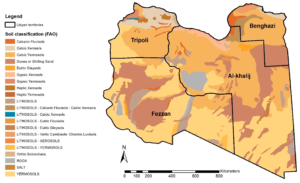| Soil Classification: Soils and their characteristics in Libya are affected to great extent by the nature and conditions in which these soils were formed in different areas of the country. Generally, aridity is the main characterizes of such soils. Most of these soils are undeveloped or partly developed and may include one diagnostic horizon or a number of diagnostic horizons which characterize the arid areas. The main characteristics of Libyan soil are low organic matter, low nutrients and high levels of calcium carbonates. Soils in Libya are classified in accordance with US Soil Taxonomy as shown in Table (1) (Ben Mahmoud, 1995). According to FAO Soil Classification System the major soil classes can be identified (FAO, 2002), shown in Table (2) |
Table (1) Soil Classification in Libya in accordance with US Taxonomy
| No. | Soil Order | Sub order | Sub Groups |
| 1 | Entisols | Psamments | Torripsamments- Xeropsamments |
| Fluvents | Torrifluvents-Xerofluvents | ||
| Orthents | Torriorthents-Xerorthents | ||
| 2 | Aridisols | Argids | Paleargids-Haploargids |
| Salids | Haplosalids-Aguisalids | ||
| Calcids | Haplocalcids | ||
| Gypsids | Haplogypsids-Petrogypsids | ||
| Cambids | Haplocambids | ||
| 3 | Alfisols | Xeralfs | Rhodxeralfs-Natrixeralfs- Haploxeralfs |
| 4 | Mollisols | Rendolls | Haplorendolls |
| 5 | Inceptisols | Xerepts | Haploxerpts |
| 6 | Vertisols | Xerets | Haploxerets |
Table (2) Major Soil Classes in Libya according to FAO (2002)
| No. | Soil Classes | Sub Classes |
| 1 | Regosols (R) | Gelic Regosols (Rx) -Calcaric Regosols (Rc) Dystric Regosols (Rd) -Eutric Regosols (Re). |
| 2 | Luvisols (L) | Plinthic Luvisols (Lp)- Gleyic Luvisols (Lg)- Albic Luvisols (La)Vertic Luvisols (Lv)- Calcic Luvisols (Lk)- Ferric Luvisols (Lf)
Chromic Luvisols (Lc) – Orthic Luvisols (Lo) |
| 3 | Lithosols (I) | —— |
| 4 | Fluvisols (J) | Thionic Fluvisols (Jt) – Calcaric Fluvisols (Jc)- Dystric Fluvisols (Jd)Eutric Fluvisols (Je) |
| 5 | Yermosols (Y) | Takyric Yermosols (Yt) – Luvic Yermosols (Yl)- Gypsic Yermosols (Yk) – Calcic Yermosols (Yc) – Haptic Yermosols (Yh). |
| 6 | Xerosols (X) | Luvic Xerosols (Xl) – Gypsic Xerosols (Xy) – Calcic Xerosols (Xk)Haplic Xerosols (Xh). |
| 7 | Solonchaks (Z) | Gleyic Solonchaks (Zg)- Takyric Solonchaks (Zt)- Mollic Solonchaks (Zm)- Orthic Solonchaks (Zo). |
| 8 | Cambisols (B) | Gelic Cambisols (Bx)- Gleyic Cambisols (Bg)- Vertic Cambisols (Bv)-Calcic Cambisols (Bk)- Humic Cambisols (Bh)- Ferralic Cambisols (Bf)
Dystric Cambisols (Bd)- Chromic Cambisols (Bc)- Eutric Cambisols (Be) |
| 9 | Salt | Salt Flats |
| 10 | Rock | Rock debris or desert detritus- |
| 11 | D/SS | Dunes or Shifting Sand |

Source (https://www.mdpi.com/2073-445X/8/5/82)
| References:Ben Mahmoud, Khaled Ramadan (1995): Libyan soils. First edition – Publisher National Commission for Scientific Research-Tripoli-Libya. (in Arabic)
Soil map of Libya: Zurqani, H.A., Mikhailova, E.A., Post, C.J., Schlautman, M.A. and Elhawej, A.R. (2019) Review A Review of Libyan Soil Databases for Use within an Ecosystem Services Framework. Land 2019, 8, 82; doi:10.3390/land8050082. |
| :أنواع الترب الليبية |
| انواع الترب الليبية جزء اول |
| انواع الترب الليبية جزء ثاني |